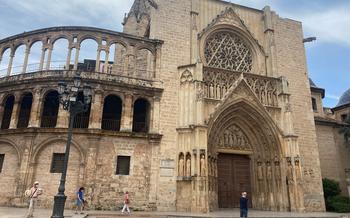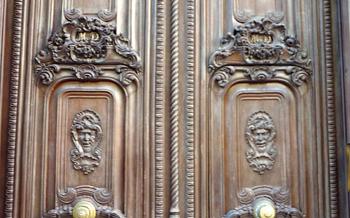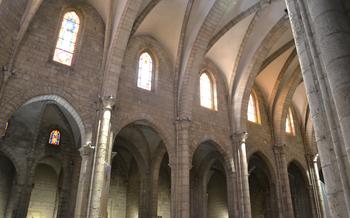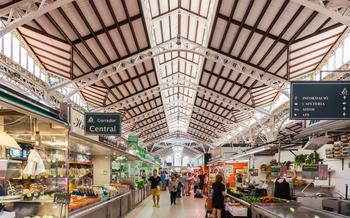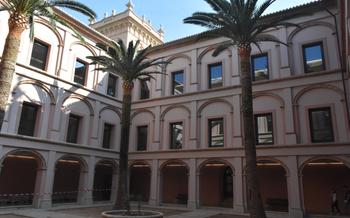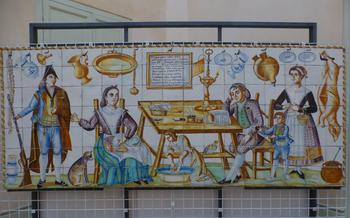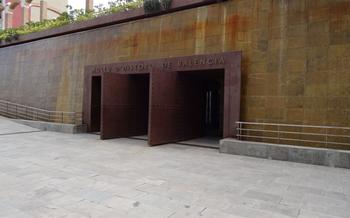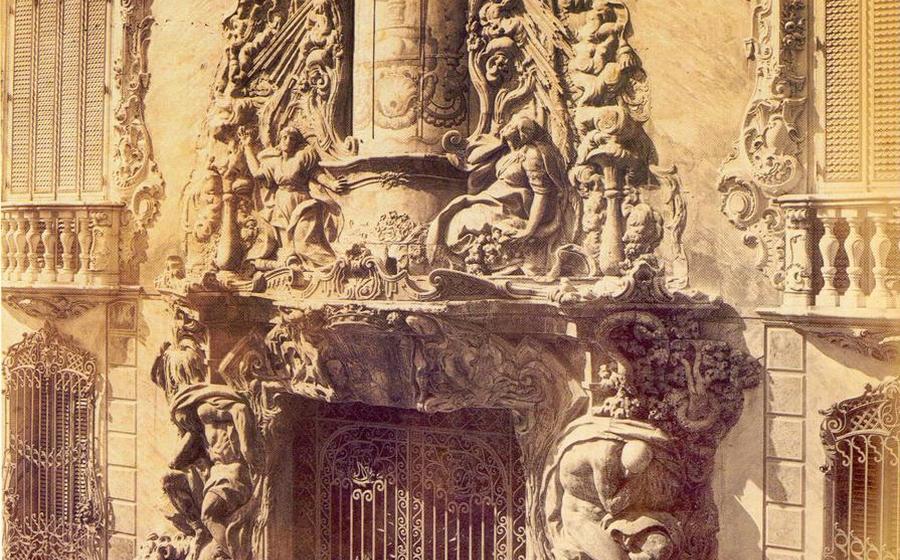
Marqués de Dos Aguas Palace
- The Marqués de Dos Aguas Palace: A Masterpiece of Rococo Architecture
- Exploring the Palace's Lavish Façade
- The Main Entrance: A Grand Welcome
- The Balcony: A Stage for Nobility
- The Rococo Style: Playful Elegance
- The Ceramic Tiles: A Colorful Tapestry
- The Palace's Historical Significance
- Guided Tours and Special Events
- Accessibility and Facilities
- Photography and Social Media
- The Palace's Enchanting Courtyard
- The Palace's Location and Surroundings
- The Palace's Cultural Significance
- Local Legends and Anecdotes
- Tips for Visiting the Palace
- Insider Tip: Hidden Gem within the Palace
The Marqués de Dos Aguas Palace: A Masterpiece of Rococo Architecture
In the heart of Valencia, Spain, stands the Marqués de Dos Aguas Palace, a testament to the city's rich cultural heritage and a masterpiece of Rococo architecture. Built in the 18th century by the Marqués de Dos Aguas, this opulent palace is renowned for its intricate façade, lavish interior decorations, and valuable collection of artwork and artifacts. Step inside this architectural gem and immerse yourself in the grandeur of the Valencian nobility, as you explore its stunning halls, admire its exquisite artwork, and uncover the fascinating stories behind its walls.
Exploring the Palace's Lavish Façade
The Main Entrance: A Grand Welcome
The palace's main entrance is a testament to its grandeur, featuring an intricate stone archway adorned with elegant carvings. The focal point is the magnificent wooden door, adorned with intricate metalwork and topped by an elaborate pediment. The door handles, shaped like mythical creatures, add a touch of whimsy to the otherwise formal entrance.
The Balcony: A Stage for Nobility
Overlooking the bustling city streets, the balcony of the Marqués de Dos Aguas Palace is a symbol of the family's power and prestige. Imagine the Marqués and his guests stepping out onto this balcony, acknowledging the crowds below with a wave or a nod. The wrought-iron railings, with their intricate scrollwork, provide a delicate contrast to the sturdy stone façade.
The Rococo Style: Playful Elegance
The Rococo style, with its characteristic asymmetry, ornamentation, and curved lines, is showcased in the palace's façade. The curving balconies, the playful cherubs, and the abundance of decorative elements create a sense of movement and energy. The soft pastel colors, such as pale pink and mint green, add to the overall charm and elegance of the exterior.
The Ceramic Tiles: A Colorful Tapestry
One of the most striking features of the palace's façade is the vibrant ceramic tiles that adorn the spandrels and window surrounds. These tiles, depicting scenes from mythology and everyday life, bring color and life to the building's exterior. The intricate patterns and vivid colors create a mesmerizing effect, inviting visitors to linger and admire the artistry.
The Palace's Historical Significance
The Marqués de Dos Aguas Palace holds great historical significance as a testament to Valencia's rich cultural heritage. The Marqués de Dos Aguas family, who resided in the palace, played a prominent role in Valencian society for centuries. They were renowned patrons of the arts and culture, actively supporting local artists and contributing to the city's cultural development. Under their stewardship, the palace became a vibrant center for social and cultural gatherings, hosting lavish events, receptions, and performances.
Throughout history, the palace has witnessed numerous events that have shaped Valencia's cultural identity. It served as a meeting place for intellectuals, artists, and dignitaries, fostering the exchange of ideas and artistic expression. The palace's role in Valencian society extended beyond its walls, as it became a symbol of the city's cultural and economic prosperity. Its architectural grandeur and artistic treasures attracted visitors from across the region, contributing to Valencia's reputation as a cultural hub.
In the 20th century, the palace underwent a significant restoration project aimed at preserving its architectural integrity and artistic heritage. This meticulous effort involved the restoration of its intricate façade, the refurbishment of its grand interiors, and the recovery of lost or damaged artworks. The successful completion of this project ensured the palace's continued legacy as a cultural landmark and a source of pride for the city of Valencia.
Today, the Marqués de Dos Aguas Palace stands as a testament to the city's rich history and cultural heritage. It serves as a museum and cultural venue, hosting exhibitions, concerts, and educational programs that promote and celebrate Valencian art and culture. The palace's ongoing role in preserving and showcasing Valencia's cultural identity makes it a must-visit destination for anyone interested in exploring the city's cultural roots and artistic traditions.
Guided Tours and Special Events
The Marqués de Dos Aguas Palace offers guided tours in various languages, providing visitors with an in-depth understanding of its history, architecture, and art collection. These tours are led by knowledgeable guides who share fascinating insights and anecdotes about the palace and its former inhabitants. Visitors can choose from general admission tours that cover the main highlights to themed tours that focus on specific aspects such as the palace's Rococo architecture or its collection of tapestries.
In addition to guided tours, the palace occasionally hosts special events, such as concerts, exhibitions, and cultural gatherings. These events offer a unique opportunity to experience the palace's opulent atmosphere and vibrant energy. Visitors can enjoy live music performances, admire stunning art displays, or participate in educational programs designed to shed light on the palace's rich history and cultural significance.
The palace also organizes thematic tours that delve into specific aspects of its history or collection. These tours are tailored to the interests of different groups, such as architecture enthusiasts, art lovers, or families with children. Educational programs are also available for students and groups, providing an engaging and interactive way to learn about the palace and its significance.
Accessibility and Facilities
The Marqués de Dos Aguas Palace is committed to providing a welcoming and accessible experience for all visitors. The palace features a number of accessibility features to ensure that visitors with disabilities can fully enjoy their visit. These features include ramps and elevators for wheelchair access, as well as adapted restrooms. Visitors with disabilities are encouraged to contact the palace in advance to inquire about any specific accommodations they may require.
In addition to accessibility features, the palace also offers a range of family-friendly amenities. Stroller parking and changing tables are available for the convenience of parents with young children. Children's activities are also occasionally offered, making the palace a great destination for families.
Visitors to the palace can also enjoy a variety of other amenities, including a museum shop and a cafeteria. The museum shop offers a selection of souvenirs, books, and reproductions related to the palace. The cafeteria provides a range of refreshments and dining options, allowing visitors to take a break from exploring the palace and relax in a beautiful setting.
Photography and Social Media
Visitors to the Marqués de Dos Aguas Palace are encouraged to capture the beauty of the palace through photography. However, certain guidelines must be followed to ensure the preservation of the palace and the comfort of other visitors. Flash photography and the use of tripods are prohibited within the palace to prevent damage to the delicate artwork and artifacts.
The palace embraces social media and encourages visitors to share their experiences and photos using specific hashtags. This allows the palace to connect with a wider audience and showcase the palace's splendor to the world. Visitors are encouraged to share their unique perspectives and experiences of the palace, creating a vibrant online community that celebrates the palace's rich history and cultural significance.
The Palace's Enchanting Courtyard
The Marqués de Dos Aguas. Step through the arched entrance and be greeted by a central fountain, its gentle water trickling, creating a tranquil ambiance. Lush vegetation surrounds the fountain, adding a touch of verdant beauty to the space.
Orange trees, emblematic of Valencia, line the perimeter of the courtyard, their fragrant blossoms filling the air with a sweet citrus aroma. These trees not only provide a touch of Mediterranean charm but also offer a shady retreat from the summer sun.
The courtyard serves as a versatile space, hosting outdoor events, receptions, and concerts during the warmer months. Its enchanting atmosphere, combined with the palace's grandeur, creates a magical setting for these special occasions. Visitors can mingle amidst the orange trees, enjoying live music or savoring delicious refreshments while immersing themselves in the palace's rich history and charm.
The Palace's Location and Surroundings
Nestled in the heart of Valencia's historic center, the Marqués de Dos Aguas Palace stands as a testament to the city's rich architectural heritage. Its strategic location within the old town places it in close proximity to a wealth of other landmarks, cultural attractions, and historical sites. Just a short stroll away, visitors can explore the majestic Valencia Cathedral, marvel at the remnants of the ancient Roman city walls, or wander through the bustling Central Market, a vibrant hub of culinary delights.
The palace's convenient location is further enhanced by its excellent transportation links. Several bus routes stop nearby, and the nearest metro station, Colón, is just a few minutes' walk away. This makes it easy for visitors to integrate a visit to the Marqués de Dos Aguas Palace into their broader exploration of Valencia's many treasures.
For those arriving by car, parking facilities are available in the vicinity of the palace. Both public and private parking options are available, ensuring that visitors can park their vehicles safely and conveniently.
The Palace's Cultural Significance
The Marqués de Dos Aguas Palace stands Rococo design, priceless artwork, and historical significance have earned it recognition as a national monument. The palace has played a pivotal role in promoting and showcasing Valencian art and culture, both past and present. It houses a significant collection of paintings, sculptures, furniture, and tapestries, representing the work of renowned Valencian artists and artisans. Through exhibitions, events, and educational programs, the palace actively contributes to the preservation and dissemination of Valencian cultural traditions. Its status as a cultural landmark attracts visitors from around the world, contributing to Valencia's tourism industry and enhancing its reputation as a vibrant and culturally rich city. The palace has received numerous awards and accolades for its cultural and architectural value, further solidifying its position as an icon of Valencian pride and identity.
Local Legends and Anecdotes
The Marqués de Dos Aguas Palace is steeped in local legends and anecdotes that add to its mystique and charm. One popular legend tells of the Marqués himself, who is said to have made a pact with the devil in order to acquire the wealth and power that allowed him to build the palace. According to the tale, the devil demanded the Marqués' soul in exchange, but the Marqués outsmarted him by tricking him into signing a contract that stated the devil could only claim his soul if the palace was ever completed. The Marqués then purposely left one small detail unfinished, ensuring that the devil would never be able to collect his due.
Another legend speaks of a hidden treasure buried somewhere within the palace grounds. It is said that the Marqués, fearing that his riches would be stolen or confiscated, buried a vast fortune in gold and jewels beneath the palace. Over the years, many have searched for the treasure, but none have ever been successful.
The palace is also rumored to be haunted by the ghosts of its former occupants. Visitors have reported seeing apparitions of the Marqués and his family wandering the halls, or hearing disembodied voices and footsteps. Some say that the ghosts are restless spirits who are unable to find peace due to the unfinished state of the palace.
Finally, there is the legend of the palace's secret passages. It is said that a network of tunnels and hidden rooms exists beneath the palace, connecting it to other locations in the city. These passages were allegedly used by the Marqués to escape from danger or to transport his treasure. While no definitive evidence of these passages has ever been found, the rumors persist, adding to the intrigue and mystery of the Marqués de Dos Aguas Palace.
Tips for Visiting the Palace
To make the most of your visit to the Marqués de Dos Aguas Palace, consider these helpful tips:
-
Best Time to Visit: Aim for the shoulder seasons (spring or fall) to avoid the summer crowds and enjoy more pleasant weather. The palace is also open on select holidays, offering a unique opportunity to experience it in a festive atmosphere.
-
Avoiding Crowds: To beat the crowds, arrive early in the morning or opt for a late afternoon visit. Guided tours are available and can provide valuable insights into the palace's history and architecture.
-
Photography Tips: Take advantage of the natural light streaming through the palace's windows to capture stunning photos. Use a wide-angle lens to capture the grandeur of the interior spaces and don't forget to look up to capture the intricate details of the ceilings.
-
Dress Code: While there is no strict dress code, it's recommended to dress respectfully, considering the palace's historical and cultural significance. Avoid wearing shorts, tank tops, or overly casual attire.
Insider Tip: Hidden Gem within the Palace
Beyond the public areas of the Marqués de Dos Aguas Palace, there lies a world of hidden treasures waiting to be discovered. One such gem is the secret room, a secluded chamber accessible only to a select few. This room is rumored to have been used by the Marqués family for clandestine meetings or to store valuable possessions. Its existence is known to only a handful of people, adding to its allure and mystique.
Another hidden gem is the private chapel, a sacred space reserved for the exclusive use of the Marqués family. This chapel is adorned with intricate religious artwork and opulent furnishings, reflecting the family's deep devotion. Visitors are granted rare access to this sacred space on special occasions, offering a glimpse into the private religious life of the Marqués family.
For those seeking breathtaking views, the rooftop terrace offers a panoramic vista of Valencia's cityscape and the surrounding countryside. This exclusive vantage point allows visitors to admire the city's architectural landmarks, the lush gardens, and the distant Mediterranean Sea. Access to the rooftop terrace is limited and subject to availability, making it a truly special experience.
Finally, the underground vaults beneath the palace hold a treasure trove of forgotten artifacts and remnants of the past. These vaults were once used for storage and safekeeping but have since been transformed into a fascinating museum. Visitors can explore these subterranean chambers and discover a hidden world of history and intrigue.
